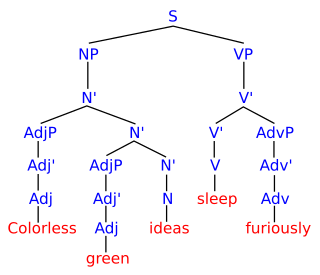
A finite-state machine (FSM) or finite-state automaton, finite automaton, or simply a state machine, is a mathematical model of computation. It is an abstract machine that can be in exactly one of a finite number of states at any given time. The FSM can change from one state to another in response to some inputs; the change from one state to another is called a transition. An FSM is defined by a list of its states, its initial state, and the inputs that trigger each transition. Finite-state machines are of two types—deterministic finite-state machines and non-deterministic finite-state machines. For any non-deterministic finite-state machine, an equivalent deterministic one can be constructed.

In logic, mathematics, computer science, and linguistics, a formal language consists of words whose letters are taken from an alphabet and are well-formed according to a specific set of rules called a formal grammar.

Automata theory is the study of abstract machines and automata, as well as the computational problems that can be solved using them. It is a theory in theoretical computer science with close connections to mathematical logic. The word automata comes from the Greek word αὐτόματος, which means "self-acting, self-willed, self-moving". An automaton is an abstract self-propelled computing device which follows a predetermined sequence of operations automatically. An automaton with a finite number of states is called a finite automaton (FA) or finite-state machine (FSM). The figure on the right illustrates a finite-state machine, which is a well-known type of automaton. This automaton consists of states and transitions. As the automaton sees a symbol of input, it makes a transition to another state, according to its transition function, which takes the previous state and current input symbol as its arguments.

In computer science and automata theory, a deterministic Büchi automaton is a theoretical machine which either accepts or rejects infinite inputs. Such a machine has a set of states and a transition function, which determines which state the machine should move to from its current state when it reads the next input character. Some states are accepting states and one state is the start state. The machine accepts an input if and only if it will pass through an accepting state infinitely many times as it reads the input.

In the theory of computation, a branch of theoretical computer science, a deterministic finite automaton (DFA)—also known as deterministic finite acceptor (DFA), deterministic finite-state machine (DFSM), or deterministic finite-state automaton (DFSA)—is a finite-state machine that accepts or rejects a given string of symbols, by running through a state sequence uniquely determined by the string. Deterministic refers to the uniqueness of the computation run. In search of the simplest models to capture finite-state machines, Warren McCulloch and Walter Pitts were among the first researchers to introduce a concept similar to finite automata in 1943.
In formal language theory within theoretical computer science, an infinite word is an infinite-length sequence of symbols, and an ω-language is a set of infinite words. Here, ω refers to the first infinite ordinal number, modeling a set of natural numbers.
In formal language theory, an alphabet, sometimes called a vocabulary, is a non-empty set of indivisible symbols/characters/glyphs, typically thought of as representing letters, characters, digits, phonemes, or even words. Alphabets in this technical sense of a set are used in a diverse range of fields including logic, mathematics, computer science, and linguistics. An alphabet may have any cardinality ("size") and, depending on its purpose, may be finite, countable, or even uncountable.
In mathematics and theoretical computer science, an automatic sequence (also called a k-automatic sequence or a k-recognizable sequence when one wants to indicate that the base of the numerals used is k) is an infinite sequence of terms characterized by a finite automaton. The n-th term of an automatic sequence a(n) is a mapping of the final state reached in a finite automaton accepting the digits of the number n in some fixed base k.
In quantum computing, quantum finite automata (QFA) or quantum state machines are a quantum analog of probabilistic automata or a Markov decision process. They provide a mathematical abstraction of real-world quantum computers. Several types of automata may be defined, including measure-once and measure-many automata. Quantum finite automata can also be understood as the quantization of subshifts of finite type, or as a quantization of Markov chains. QFAs are, in turn, special cases of geometric finite automata or topological finite automata.
In computer science, more specifically in automata and formal language theory, nested words are a concept proposed by Alur and Madhusudan as a joint generalization of words, as traditionally used for modelling linearly ordered structures, and of ordered unranked trees, as traditionally used for modelling hierarchical structures. Finite-state acceptors for nested words, so-called nested word automata, then give a more expressive generalization of finite automata on words. The linear encodings of languages accepted by finite nested word automata gives the class of visibly pushdown languages. The latter language class lies properly between the regular languages and the deterministic context-free languages. Since their introduction in 2004, these concepts have triggered much research in that area.
In computer science and mathematical logic, an infinite-tree automaton is a state machine that deals with infinite tree structures. It can be seen as an extension of top-down finite-tree automata to infinite trees or as an extension of infinite-word automata to infinite trees.
In automata theory, McNaughton's theorem refers to a theorem that asserts that the set of ω-regular languages is identical to the set of languages recognizable by deterministic Muller automata. This theorem is proven by supplying an algorithm to construct a deterministic Muller automaton for any ω-regular language and vice versa.
In automata theory, a generalized Büchi automaton is a variant of a Büchi automaton. The difference with the Büchi automaton is the accepting condition, which is determined by a set of sets of states. A run is accepted by the automaton if it visits at least one state of every set of the accepting condition infinitely often. Generalized Büchi automata are equivalent in expressive power to Büchi automata; a transformation is given here.
In automata theory, a timed automaton is a finite automaton extended with a finite set of real-valued clocks. During a run of a timed automaton, clock values increase all with the same speed. Along the transitions of the automaton, clock values can be compared to integers. These comparisons form guards that may enable or disable transitions and by doing so constrain the possible behaviors of the automaton. Further, clocks can be reset. Timed automata are a sub-class of a type hybrid automata.
In automata theory, an unambiguous finite automaton (UFA) is a nondeterministic finite automaton (NFA) such that each word has at most one accepting path. Each deterministic finite automaton (DFA) is an UFA, but not vice versa. DFA, UFA, and NFA recognize exactly the same class of formal languages. On the one hand, an NFA can be exponentially smaller than an equivalent DFA. On the other hand, some problems are easily solved on DFAs and not on UFAs. For example, given an automaton A, an automaton A′ which accepts the complement of A can be computed in linear time when A is a DFA, whereas it is known that this cannot be done in polynomial time for UFAs. Hence UFAs are a mix of the worlds of DFA and of NFA; in some cases, they lead to smaller automata than DFA and quicker algorithms than NFA.
In model checking, a subfield of computer science, a signal or timed state sequence is an extension of the notion of words in a formal language, in which letters are continuously emitted. While a word is traditionally defined as a function from a set of non-negative integers to letters, a signal is a function from a set of real numbers to letters. This allow the use of formalisms similar to the ones of automata theory to deal with continuous signals.
In model checking, a subfield of computer science, a clock is a mathematical object used to model time. More precisely, a clock measures how much time passed since a particular event occurs, in this sense, a clock is more precisely an abstraction of a stopwatch. In a model of some particular program, the value of the clock may either be the time since the program was started, or the time since a particular event occurred in the program. Those clocks are used in the definition of timed automaton, signal automaton, timed propositional temporal logic and clock temporal logic. They are also used in programs such as UPPAAL which implement timed automata.
In automata theory, a field of computer science, a signal automaton is a finite automaton extended with a finite set of real-valued clocks. During a run of a signal automaton, clock values increase all with the same speed. Along the transitions of the automaton, clock values can be compared to integers. These comparisons form guards that may enable or disable transitions and by doing so constrain the possible behaviors of the automaton. Further, clocks can be reset.
An alternating timed automaton (ATA) is a modeling formalism that combines features of timed automaton and an alternating finite automaton to succinctly express sets of timed event sequences. Classical timed automata only allow existential nondeterministic branching in their transitions, while alternating finite automata model discrete untimed behaviors. Unlike timed automata, alternating timed automata are closed under complementation. However, this increased expressive power comes at the cost of undecidability in their emptiness problem. A one clock alternating timed automaton (OCATA) is a restricted version of an ATA, limited to the use of a single clock. OCATAs can express timed languages that cannot be expressed using standard timed automata.
In model checking, a field of computer science, a region is a convex polytope in for some dimension , and more precisely a zone, satisfying some minimality property. The regions partition .















